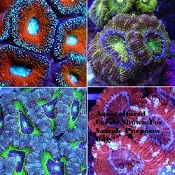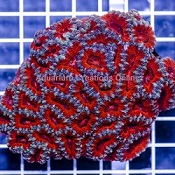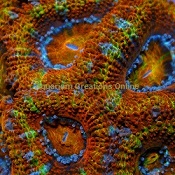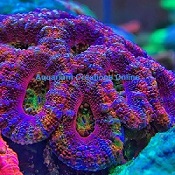Acanthastrea coral commonly known as the Acan Coral or Acan Lords. They are an LPS coral (Large Polyp Stony). They come in various shades of purple, red, green, blue, orange, brown, rust or pale tan to pale grey. The amazing color varieties make most show stoppers. Acan corals are a hardy and easy to care for coral, perfect for the beginner aquarist. The family includes many species, which have a lot of different names and are touted by many as one of the easiest LPS corals to grow. Due to their popularity and the mind-numbing array of color choices, you will find many colors and varieties of Acan corals available under different names. Names such as the Australian Lord (or Aussie Lord), higher priced Rainbow Acan corals, etc.
Lighting Acanthastrea are a photosynthetic coral, and gain nutrition through their available light, but high power lighting is not necessary for the Acan, they are perfectly happy on the lower end of moderate. We recommend a moderate lighting level of no more than 100 PAR. We also recommend the addition of actinic blue LED lights to bring out the Acan's amazing corals fluorescents. Acan corals are adaptable to different lighting intensities, but the best rule of thumb is "less instead of more", don't fry your coral with too much light. We see it happen way to often. You also want to situate this coral in a place with moderate (medium) level of water flow. Not to much, but not to little. Remember, though it may look like a soft coral, it is a LPS (large polyp stony) coral and you don’t want he water flow to be so high that it could harm the soft flesh.
Aquaculture Possibilities Often found for sale in small fragments, Acanthastrea corals can easily propagate through correct fragging techniques and allowing to grow. Fragging Acans is possible and relatively straightforward as long as you have the right power tools to execute a fast, safe cut. It certainly shouldn't be the first coral fragging experiment, but if you have the correct tool, a wet operating band saw, you can cut sections from larger colonies. This technique works well for culturing Acan's.
Diet & Feeding Acan corals are considered to be photosynthetic, meaning they derive a portion of their calories from the commensal zooxanthellae that live in their tissue. When it's feeding time, an Acan coral will extend its polyps to capture prey—copepods, artemia, chopped seafood or even commercial foods—frozen, flake or pellet. As long as it can catch it and pull it in, the food can be eaten. The second way of feeding an Acan is considered more difficult but sometimes very rewarding, called “target feeding.” The growth rates of Acan corals are highly influenced by target feeding. This process involves the use of pipettes to administer coral food directly over each Acan polyp. A gentle blast of food once or twice a week and watch your Acan's grow!
|




